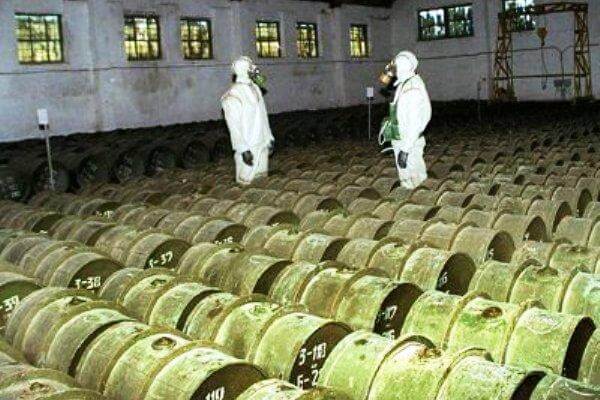The destruction of Syria's chemical weapons stockpiles at sea will be an all-civilian operation by U.S. Defense Department personnel with the toxic waste from the destruction process to be disposed of in third-country landfills, Pentagon officials said Thursday.
"Our assessment is that the risks from the neutralization process is very low" in destroying the liquid stocks of mostly mustard gas blistering agent and the nerve agent sarin, said a senior DoD official who specializes in weapons of mass destruction.
"We think this is a relatively low-risk operation," said the official, who spoke on grounds of anonymity. The official added that "I want to be clear that absolutely nothing will be dumped at sea."
At a Pentagon briefing, three senior officials involved in the politically-charged plan to destroy chemical weapons for the first time at sea said that details were still being worked out with the international Organization for the Prohibition of Chemical Weapons, but the operation will not involve sending any U.S. personnel, military or civilian, into Syria.
The OPCW has called on Syrian authorities to move about 200 tons of chemical agents to the port of Latakia before Dec. 31. The agents, which could be used to make mustard gas and sarin, were in liquid form and had not yet been weaponized into artillery shells or bombs, the Pentagon officials said.
The liquid agents will be put into special containers supplied by the U.S. and then picked up by a ship contracted by the OPCW – likely a Norwegian vessel – to be taken to another Mediterranean port that has yet to be determined.
At the second port, the OPCW ship will be met by the 648-foot MV Cape Ray, a Roll-on/Roll-off ship owned by the U.S. Maritime Administration, which is part of the Transportation Department. About 60 civilian DoD specialists will be aboard the Cape Ray in addition to its civilian crew of about 25-30, the Pentagon officials said.
The Cape Ray was being outfitted below decks with two Field Deployable Hydrolysis Systems to dilute the liqud agents with water and bleach. Waste products from the process would be disposed of in countries that have yet to be named, the officials said, and it also has yet to be determined whether the destruction at sea would take place in the Mediterranean or elsewhere.
The officials said that the Cape Ray was expected to leave its homeport of Norfolk, Va, sometime in January and the destruction process would take 45-90 days.
Cost estimates for the operation ordered by the OPCW have yet to be finalized, the officials said, but the Obama administration has pledged contributions to "a destruction technology, full operational support and financing to neutralize" the chemicals.
In a separate operation, the OPCW was negotiating to have nearly 800 tons of dual-use chemicals, many of which are common industrial chemicals, to be removed from Syria by Feb. 5 and later destroyed by private companies as part of the organization's ambitious plan to completely eradicate Syria's chemical weapons program by mid-2014.
The OPCW took on the job of destroying Syria's chemical weapons under a Sept. 14 agreement between the U.S. and Russia, Syria's main ally that was endorsed by the United Nations. The agreement forestalled a U.S. attack in retaliation for Syria's chemical weapons attack in the Damascus suburbs that reportedly killed hundreds on Aug. 21.






























